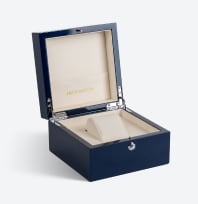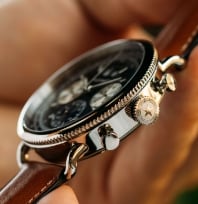When first invented, there was only one type of watch: the pocket watch. As the decades ticked on, many new designs became available—by the end of World War I, the wristwatch had overtaken the pocket watch in popularity.
These days, there are countless wristwatches for sale, each with its own features and limitations. With so many options on the market, we wanted to walk you through the various types of watches that are available—not only is it important to be an informed customer, but we think it’s fascinating to learn about how these timepieces work. Read on for a description of everything you’ll find when looking for a new watch.
Types of Watch Movements
There are three different types of mechanisms, known as movements, that watchmakers use to craft their watches: mechanical, automatic, and quartz.
Mechanical
This is the classic. The first watches were mechanical, containing intricate inner workings that revolve around the use of the mainspring—the component that powers the watch.
The tightly-wound mainspring gradually releases tension over a set period of time, in turn activating all of the wheels and other components inside the watch. Over a long enough time, it will eventually lose tension; to keep your mechanical watch ticking, you have to keep that mainspring wound.
Automatic
Also known as a self-winding watch or a perpetual motion watch, automatic watches contain all of the same intricacies of mechanical watches—with an added feature.
While the old-school mechanical watch needs to be wound by hand to keep working, an automatic watch has a self-winding mechanism that uses the kinetic energy of the watch’s wearer (i.e., when they swing their arms as they walk) to keep the mainspring wound.
Quartz
This is a more recent method for powering watches. Instead of all the intricate inner workings of mechanical and automatic movements, quartz movements use an internal battery. Because of their simplicity, many quartz watches are more affordable than their complex counterparts.
Watch Displays
Seeing as the main purpose of a watch is to tell the time, how the time is displayed is very important. Here are the different designs that you’ll see (or feel):
Analog
This is the most traditional and common display type for watches—and timepieces in general. Pretty much every classroom in America has an analog clock on the wall…and pretty much every student in America has found themselves staring at the second hand at some point in their tenure. If the clock has hands that turn and point to numbers on a dial, that’s an analog display.
Digital
Digital displays use an LCD screen to show the time. You’ll find digital displays on ovens, microwaves, coffee machines, and pretty much any appliance that includes a timekeeping feature.
Digital watches are popular for their ability to instantly tell time without having to interpret the positioning of the hands on a watch’s face—people who have difficulty reading analog displays will probably prefer digital options.
Hybrid
As one might assume from the name, this is a combination of analog and digital. Many different watch types feature hybrid displays, ranging from simpler designs—with a traditional analog face and an additional digital display—to those with more complicated features (for instance, watches that include fitness trackers or the ability to connect with a smartphone).
Tactile
This specialized type of watch can tell time without needing to look at a display. Tactile watches were created in the early 1800s so that people could discreetly know the time without having to take their watch out of their pocket (back in the days before wristwatches).
These days, tactile watches are helpful for the blind. Braille watches are also available for that purpose.
Touchscreen
The Information Age has brought us some pretty incredible equipment, including smartwatches. While tiny little wrist computer-communicators used to be a thing of science fiction, reserved for the likes of James Bond and Buzz Lightyear, these days, smartwatches are available from a variety of retailers.
Since smartwatches offer multitudes of features and applications, there’s not enough room on the watch face to display everything at once—necessitating a touchscreen display. This feature makes it possible to switch screens and scroll through messages and articles. (Extra points if you’re reading this article on a watch right now.)
Watch Styles
While the inner workings of a watch and how it displays time are perhaps the most important aspects of a watch’s design, many people are just as concerned with the style of watch—and for a good reason.
There are a wide variety of watch styles, from the extremely casual to the ultra-luxurious. You don’t want to show up to a gala with a $20 drugstore watch on your wrist (unless you’re trying to make a specific statement), and you might invoke the disdain of fellow gymgoers if you show up to your workout sporting a limited-edition, vintage designer timepiece. So you need to know about the different styles of watch, and in what scenarios they’re most appropriate.
Casual Watches
Casual watches can be worn for almost any occasion. Casual watches are by your side for day-to-day activities, whether you’re running errands or finishing up work at the office. You can wear a casual watch to the gym, the store, on vacation, etc.
If your casual watch appears classy enough to wear to a wedding or an opening night, more power to you, but many casual watches look too informal for many important events.
Dress Watches
Dress watches are perfect for formal and semi-formal events—they can bring a look together or stand out as an interest piece, but ultimately they fulfill the purpose of being a component of a formal outfit.
Fashion Watches
There’s little agreement on what constitutes a fashion watch, but generally, the term applies to watches made by a brand that’s well known for their reputation in the fashion world—not for their expertise in making watches.
“Fashion watch” can be a derogatory term in that sense since it refers to a watch that may not be of the highest quality, but is aesthetically attractive and often expensive due to its manufacturer’s brand recognition.
Luxury Watches
Not to be confused with fashion watches, companies with long histories of watchmaking manufacture luxury watches. Many luxury watches contain precious materials, and their manufacturers use high-end movements and other carefully crafted components in their designs.
Luxury watches can cost thousands (or millions) of dollars. Those that can afford them are attracted to their undeniable craftsmanship.
For most people, the most important differentiation is that between casual and dress watches. Having at least a couple of options for each isn’t a bad idea. That way, you can pair any watch with any outfit—and any occasion.
Specialty Watches
There are also plenty of options when it comes to specialized types of watches. Some of the best watches have features that allow their wearers to make essential calculations, be water-resistant, or make it possible to submerge to dizzying depths.
Diving Watches
As the name suggests, diving watches are made for diving. Water resistance is the most important feature here, and the best diving watches are capable of going underwater at any depth.
Many watches have some degree of water resistance, but not all water-resistant watches have the same durability level. Make sure to double-check the features and limitations of your watch before taking it for a swim.
Pilot and Racing Watches
Pilot watches were originally designed for pilots; racing watches were designed with racecar drivers in mind. These watches can have chronometers (stopwatch capabilities) and tachymeters (customizable measurement components) that may be relied upon even in life or death situations.
Solar Watches
While there are some shortcomings to mechanical and automatic watches when it comes to maintaining accuracy (mechanical watches need to be wound and automatic watches need to be worn in order to wind themselves), solar watches combine the longevity of mechanical and automatic movements with the pinpoint accuracy of quartz movements.
Solar watches constantly charge their batteries, drawing on both natural and artificial light to do so, and are some of the most accurate watches on the market.
In Conclusion
Ultimately, the type of watch you pick is unique as you are. You might want a simple design that’s classic enough to wear every day but classy enough to wear with a suit; you might want a flashy design with plenty of additional features.
Whatever it is that you’re looking for, Jack Mason has the watch for you. Be it casual or dressy, automatic or quartz, classic or cutting-edge, we have it all. Check out our collection and see what we have to offer—we’re sure you’ll find the perfect watch for you.
Sources:












